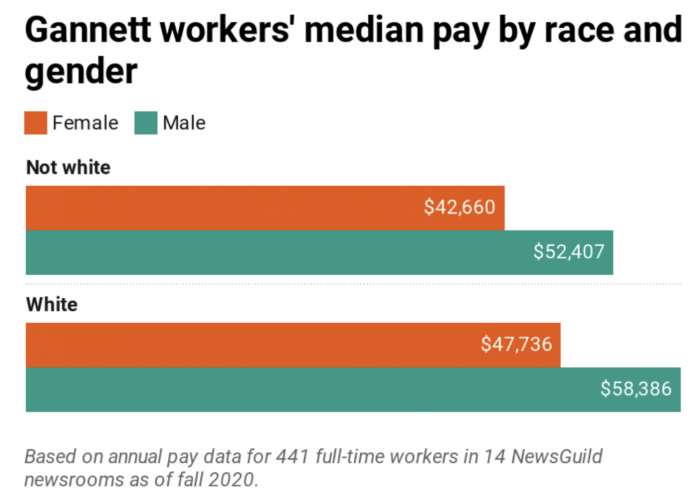
Women journalists and journalists of color aren’t paid as well as their white male counterparts in 14 Gannett newsrooms, and journalists in unionized newsrooms are paid better than those in non-unionized shops, according to a pay equity report published by NewsGuild Gannett Caucus on Tuesday.
The caucus requested salary and demographic data from Gannett for 14 newsrooms in various parts of the country and included anonymized data about 466 non-manager employees in the fall of 2020. Its analysis found that employees of color earned a median salary of $5,246 less than white employees, a 10% pay gap. Women of color earned a median salary of $15,727 less than white men, a 27% pay gap.
Women who have worked at newspapers currently owned by Gannett for at least 30 years earned $27,026 less than men in comparable positions.
“I think it’s criminal for Gannett or any other news organizations to have pay inequity based on gender or color while these same organizations expose and condemn other industries of doing the same,” a journalist for the Sarasota Herald-Tribune said in the report. “It’s the typical do as I say, not as I do.”
“I remember the punched-in-the-gut feeling I had the moment I learned that a young male reporter with just a few years of experience had nearly the exact same salary that I had, despite my two decades as a working journalist,” a Milwaukee Journal Sentinel journalist said.
The largest gender and racial pay gaps were at The Arizona Republic, the study found. There, women’s median salary was just 61% of what men made, costing “women nearly $30,000 in median yearly earnings.” The median salary for employees of color was just 63% of what white workers made.
“The pay inequity that I experienced during my time in the newsroom was pretty much in plain sight the entire time. In 2018 and 2019, as a woman of color with a bachelor’s degree, I wrote original content and was paid less than $15 an hour,” one former Arizona Republic journalist said. “Not only were my male counterparts with similar background/experience getting paid more, there were INTERNS in the newsroom paid a higher wage than I was. The low pay continued even after a merit-based promotion in 2020. My official duties in the new position included THREE different jobs with an hourly wage that didn’t even properly compensate me for one of the jobs, let alone all three.”
A current Arizona Republic journalist said, “The company wanted to start me at a similar pay as new college graduates. Some of us journalists of color are in our 30s, yet we still can’t catch up to some of our younger, white colleagues. And when we speak multiple languages, the company benefits from our interviews and translations, but doesn’t pay us for that benefit.”
Gannett’s Chief People Officer Samantha Howland disputed the union’s findings on Monday evening in a company-wide email shared with Nieman Lab, saying that the report was “a misleading document based on outdated data alleging pay inequities on a small subset of Gannett’s more than 250 newsrooms.”
“Numerous actions have been undertaken on compensation,” Howland said in the email. “We are employing an external market-based approach which will ensure a fair review by role and responsibility level with considerations for geographic differences. This includes ongoing pay reviews and alignment, including pay adjustments. With each new hire, we continue to review and integrate our compensation and job structures and evaluate pay by job content, individual contributions, market and job level. Each function is on its own cycle to award selective increases that support equity goals and account for pay history, performance and potential. Gannett is committed to a pay structure that is merit-based, meaning that the company will continue to recognize employees for their unique contributions, abilities and skill, as well as other business-related factors.”

The study was conducted by Emily Hopkins, a data reporter for the Indianapolis Star; Andrew Mollica, a newsroom developer for the Milwaukee Journal Sentinel; Andrew Pantazi a former data reporter for the Florida Times-Union; Christopher Persaud, a data reporter for the Palm Beach Post; Justin Price, a data reporter for The Arizona Republic and; Rebekah Sanders, a consumer reporter for The Arizona Republic.
Gannett, which owns 260 local newspapers across the United States, has promised to make its workforce “as diverse as the country” by 2025 last summer. Its initiatives have outwardly focused on hiring and creating new beats related to social justice and racial inequality, but its announcement from August 2020 didn’t mention internal wage gaps.The study also found that unionized newsrooms fare better in terms of pay compared to non-unionized newsrooms, though pay still wasn’t equal across race and gender. The authors attributed this to the fact that unionized newsrooms implement pay scales as part of their contracts.
“The gender pay gap was $7,676 in newsrooms with longstanding union contracts compared to $14,522 in newsrooms currently negotiating first contracts,” the report’s authors write. “The racial pay gap was $837 in newsrooms with longstanding union contracts compared to $6,280 in newsrooms currently negotiating first contracts.”
Just going to cite this forever: @NewsGuild looked at pay data from Gannett newsrooms and found that pay disparities for women/people of color were dramatically lower in the newsrooms that have union contracts. These are workers ***at the same company*** https://t.co/XiKeQjusey pic.twitter.com/G939f0v2nh
— Matt Pearce 🦅 (@mattdpearce) April 27, 2021
Hey @LarkMarieAnton, the data was provided by @Gannett, analyzed by @Gannett data journalists & sent to the company ahead of publishing.
If you'd like to share the "critical analysis factors" (LOL) you've got our contact info.
Even better- release data for THE WHOLE COMPANY. https://t.co/R1XCyPtNcn
— Rebekah Sanders 🌵 (@RebekahLSanders) April 27, 2021
Read the full report here.